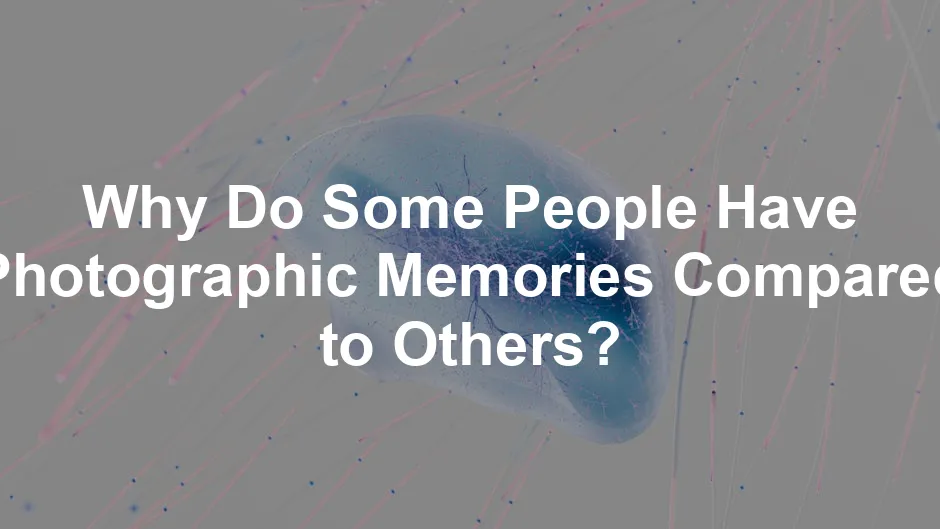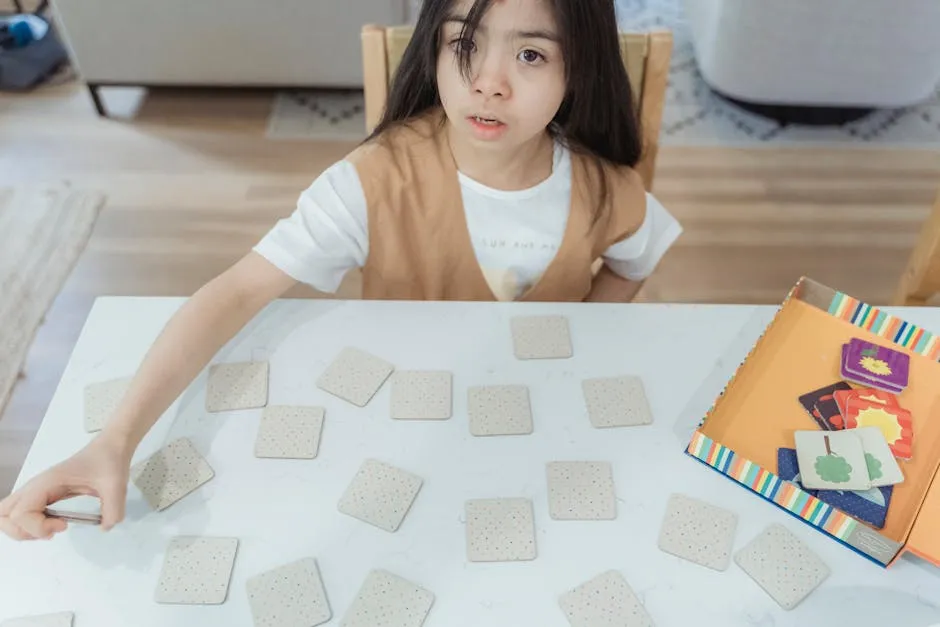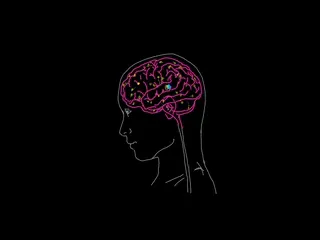
Why Do Some People Have Photographic Memories Compared to Others?
Introduction
In a world where forgetting names or losing your keys is a common occurrence, the idea of photographic memory often seems like a superpower reserved for the elite few. Imagine being able to recall every detail of a book after just a single glance or remembering a friend’s face perfectly after a fleeting encounter. While some claim to possess this extraordinary skill, the reality is much more nuanced.
Photographic memory, often confused with eidetic memory, is a term often thrown around in casual conversations. But what does it really mean? Scientifically, photographic memory is a controversial ability to recall information in minute detail, like flipping through a mental photo album. Some individuals seem to have this remarkable talent, while others struggle to remember even the smallest details.
So, why does this disparity exist? One major factor is the brain’s structure and function. Research shows that certain brain areas, such as the hippocampus, play vital roles in memory formation. However, these structures don’t operate in isolation. The way we process and encode memories varies from person to person.

If you’re looking to give your memory a workout, consider trying out some Memory Improvement Games. They’re like a gym for your brain, helping you flex those memory muscles while having a blast!
Another aspect to consider is the role of attention and perception. Those who are highly observant and attentive are likely to encode memories with greater depth. People with exceptional memory often engage in deliberate practice and may utilize techniques to improve their recall. This can include methods like visualization or mnemonic devices.
Genetics also plays a part. Some individuals may inherit traits that enhance their memory capabilities. For instance, those on the autism spectrum often showcase extraordinary memory skills. With all these factors in play, it’s clear that memory is not just a simple matter of having a “better” brain; it’s a complex interplay of biology, psychology, and environmental influences.
Speaking of techniques, if you want to dive deeper into memory strategies, check out “Memory Palaces: A Practical Guide to Memory Techniques”. It’s like building a mansion for your memories—just be careful not to forget where you put the guest room!
The Science of Memory
Understanding Memory Types
Memory is a fascinating process that helps us retain and recall information. There are two primary types of memory: short-term and long-term. Short-term memory holds information temporarily. It’s like a mental notepad. You might remember a phone number long enough to dial it, but forget it moments later. Typically, short-term memory can hold about five to nine items at once. This limitation is why we often struggle to remember lengthy lists without some form of aid.
Long-term memory, on the other hand, is where the magic happens. This type of memory stores information for extended periods, potentially a lifetime. It’s less about capacity and more about the depth of processing. When you truly understand something, you’re more likely to remember it. Facts, experiences, and skills can all find a home in long-term memory. The transition from short-term to long-term memory involves consolidation, a process that stabilizes a memory after its initial acquisition.
Now, let’s talk about working memory. This is your brain’s workspace, where you manipulate information. Think of it as the mental equivalent of a desk. You can pull out documents (information) to work on, but there’s limited space. Working memory allows you to hold information temporarily while you use it, like solving a math problem in your head. However, it’s also limited. If you overload it, you risk losing important details.

If you’re looking to enhance your cognitive skills, consider trying out Brain Training Cards. They’re an engaging way to keep your mind sharp and ready for anything life throws at you!
The Neurological Basis of Memory
Memory is intricately tied to specific brain structures. The hippocampus plays a crucial role in forming new memories. It helps convert short-term memories into long-term ones. Damage to the hippocampus can lead to difficulties in forming new memories, highlighting its importance.
The amygdala, often associated with emotions, also contributes to memory formation. Emotional memories tend to be stronger, thanks to the amygdala’s influence. This is why you might remember a particularly exciting or traumatic event vividly. Other brain areas, such as the prefrontal cortex, are involved in working memory and decision-making, showcasing the complexity of memory systems.
Genetic factors also influence memory capabilities. Some individuals may inherit specific traits that enhance their memory. Research indicates that certain genes may affect memory performance. For instance, variations in genes related to neurotransmitters can influence cognitive functions, including memory. This genetic influence might explain why some people seem to retain information more effectively than others.
If you’re serious about improving your memory, consider reading “Your Memory: How It Works and How to Improve It” by Kenneth L. Higbee. It’s a treasure trove of insights, strategies, and tips that can help you harness your memory potential!

In summary, memory is an intricate interplay of various brain structures and genetic factors. Understanding this complexity helps explain the differences in memory capabilities among individuals. While some may seem to have a natural talent for remembering, others can improve their skills with practice and training.
Eidetic vs. Photographic Memory
Defining Eidetic Memory
Eidetic memory refers to the ability to recall images with high precision after only brief exposure. It’s often described as a vivid mental snapshot. This type of memory is more commonly observed in children. Studies suggest that about 2% to 10% of children aged six to twelve exhibit eidetic memory. Children may recall visual details for several minutes after seeing them. For example, a child might look at a picture and later recreate it from memory.
However, eidetic memory tends to decline with age. As children develop other learning strategies, like reading, they may lose this ability. Adults rarely demonstrate true eidetic memory. Instead, many rely on different memory techniques, such as mnemonic devices, to aid recall.

Prevalence
Although eidetic memory is fascinating, its prevalence is limited. Most reports of eidetic memory come from childhood, with very few cases in adults. This decline may be linked to cognitive development and the shift in learning methods as people mature. As children grow, they typically rely more on language and less on visual memory.
In contrast, claims of photographic memory—often conflated with eidetic memory—remain controversial. While some individuals assert they can recall information in extraordinary detail, scientific backing for true photographic memory is lacking. As research continues, the distinction between these types of memory becomes clearer. Understanding these differences sheds light on the diverse landscape of human memory.
Photographic Memory: Myth or Reality?
Scientific Skepticism
The term “photographic memory” brings to mind extraordinary recall abilities, but is it all just a myth? Despite popular belief, scientific evidence supporting photographic memory is lacking. Many researchers argue that what people often describe as photographic memory may actually be exceptional recall skills combined with effective memory techniques. Studies show that the brain processes and stores information in complex ways, making true photographic memory difficult to substantiate.
For instance, noted cognitive scientist Marvin Minsky has expressed skepticism, suggesting that the idea of photographic memory is largely exaggerated. The brain does not function like a camera, capturing perfect images for later retrieval. Instead, memory is reconstructive, meaning it can change over time. Memories can fade, distort, or evolve, making the concept of a flawless mental snapshot questionable at best.

Notable Claims
Throughout history, various individuals have claimed to possess photographic memory. Famous figures such as Wolfgang Amadeus Mozart and Nikola Tesla are often cited as examples. However, the validity of these claims is heavily debated. Many of these supposed photographic memories are likely the result of exceptional cognitive strategies rather than an innate ability.
Take the case of Stephen Wiltshire, a British savant known for his ability to draw intricate cityscapes after brief observations. While his skills are impressive, they raise questions about the true nature of photographic memory. Wiltshire’s talent may stem from a combination of intense focus and practiced techniques rather than a traditional photographic memory.
Moreover, the story of “Elizabeth,” a woman studied by scientist Charles Stromeyer in the 1970s, adds another layer of intrigue. Elizabeth reportedly demonstrated extraordinary recall abilities, but subsequent skepticism arose concerning the testing methods used. The reproducibility of her results was never confirmed, leading many to question the legitimacy of her claims.
In summary, while some individuals exhibit remarkable memory skills, the existence of true photographic memory remains highly contentious. The combination of anecdotal evidence and scientific skepticism paints a complex picture of this fascinating phenomenon.
Emotional and Psychological Factors
Emotional Memory
Emotions can be powerful memory enhancers. Think about the last time you felt your heart race during a thrilling moment. That adrenaline rush likely etched the experience into your mind. Conversely, emotions can distort memories. Ever recall a family dinner that everyone insists was a disaster, but you swear it was a blast? Our feelings can color those memories. The brain’s amygdala, which processes emotions, works hand in hand with the hippocampus to solidify these memories. This is why you might vividly remember your first heartbreak or the joy of a wedding day. Those strong feelings create mental snapshots that linger long after the moment has passed.

If you’re looking for a fun way to keep your mind engaged, consider grabbing some Brain Teasers Puzzle Books. They not only entertain you but also stimulate your brain, helping you remember things better!
Mental Health Implications
Mental health plays a crucial role in how we remember. Take anxiety, for instance. It can cloud your mind like a foggy day, making it hard to focus and retain information. People with anxiety may struggle to form new memories. Their brains prioritize worrying over recalling facts. Conditions like PTSD can create vivid, intrusive memories of traumatic events. It’s a double-edged sword: while some memories are locked in with precision, others are distorted by emotional turmoil. This complex relationship highlights how mental health can significantly influence memory recall. Understanding these dynamics can empower individuals to manage their memory and emotions better.
Real-Life Applications and Implications
Memory in Everyday Life
Imagine a world where recalling names, dates, and important details feels effortless. Improved memory can transform your academic performance, boost your career, and enrich personal relationships. Students who master memory techniques often excel in tests, while professionals who remember key details impress colleagues and clients alike. Even in daily life, remembering a friend’s favorite coffee order can strengthen bonds. Memory isn’t just a skill; it’s a tool that can enhance every aspect of life. By harnessing memory techniques, individuals can navigate their tasks with confidence and ease.

To help with memory retention, consider exploring Fidget Spinners. They can be a great way to keep your hands busy, allowing your mind to focus on the task at hand!
Memory in Education
Understanding memory can revolutionize education. Teachers who acknowledge how memory works can adopt better teaching methods. For instance, they can use spaced repetition, which encourages students to revisit material over time. This approach aids retention far better than cramming. Incorporating memory techniques into curricula can also make learning more engaging. Imagine classrooms filled with mnemonic devices and memory palaces, where students actively participate in their learning journey. By fostering a deeper understanding of memory, educators can empower students to become lifelong learners.

If you’re interested in enhancing your learning experience, consider checking out Mind Mapping Kits. They can help you visualize your thoughts and improve your understanding of complex subjects!
The Future of Memory Research
Advancements in neuroscience are paving the way for groundbreaking discoveries in memory research. Technologies like brain imaging help scientists visualize memory processes in real-time. This could lead to exciting new therapies for memory enhancement. Imagine treatments that bolster memory for those with impairments or age-related decline. Researchers are exploring how to optimize brain function, potentially unlocking the secrets to sharper memories for everyone. As our understanding of the brain deepens, the future of memory research holds great promise for enhancing cognitive abilities.

For those curious about the science behind memory, “The Science of Learning” by Barbara Oakley is a fantastic read that delves into how we learn and remember!
Potential Therapies
The potential for therapeutic approaches targeting memory impairments is vast. Techniques like cognitive behavioral therapy (CBT) can help individuals process traumatic memories. Meanwhile, emerging treatments might utilize neurostimulation to enhance memory functions. There’s even talk of using medications to improve memory recall in those with conditions like Alzheimer’s. As research progresses, the aim is to develop therapies that not only help those with memory struggles but also enhance memory in healthy individuals. Innovations in therapy could change how we approach memory challenges, offering hope for a brighter cognitive future.
Conclusion
In conclusion, the distinction between photographic and eidetic memory, while captivating, highlights the intricate nature of human cognition. Scientific exploration into memory has revealed fascinating insights into the factors that contribute to remarkable recall abilities. Yet, it also uncovers the limitations inherent in our memory systems.
Photographic memory, often considered a myth, lacks substantial empirical evidence. However, many individuals display incredible memory capabilities, leading us to ponder the nuances of our cognitive abilities. Genetic predispositions, environmental influences, and individual training play significant roles in shaping our memory skills. For instance, those on the autism spectrum frequently exhibit exceptional recall, suggesting a fascinating intersection between neurological differences and memory capacity.

As we strive to enhance our cognitive faculties, understanding these elements becomes crucial. Individuals can adopt techniques to improve memory, such as visualization and mnemonic devices. These strategies empower people to navigate their daily lives with greater ease, transforming the act of remembering into an engaging experience.
Moreover, recognizing the uniqueness of each person’s memory journey fosters appreciation for our diverse cognitive landscapes. By embracing our differences, we can learn to value the varied ways we engage with the world. Memory is not simply a tool for recalling facts; it shapes our identities and experiences. As research continues to evolve, we may unlock even more secrets about how we remember and how we can enhance this essential aspect of our humanity.
FAQs
Is photographic memory real?
The scientific consensus leans toward skepticism regarding photographic memory. While many report exceptional recall abilities, true photographic memory remains unproven. Instead, what we often see are individuals utilizing effective memory strategies, sometimes mistaken for photographic recall.
Can memory be improved?
Absolutely! Memory can be sharpened through various techniques. Visualization exercises, mnemonic devices, and spaced repetition can significantly enhance retention. Regular practice, along with a healthy lifestyle, also contributes to improved memory performance.
What is hyperthymesia?
Hyperthymesia is a condition that allows individuals to recall personal life events with exceptional accuracy. Unlike photographic memory, which pertains to visual information, hyperthymesia is primarily autobiographical, enabling people to remember specific dates and events in detail.
Are there training methods for developing better memory?
Yes! Numerous strategies exist for memory enhancement. Techniques like the method of loci (memory palace), chunking information, and engaging in memory games can help improve recall. Consistent practice and exposure to the material are key components.
Why do some people seem to remember everything?
Exceptional memory in certain individuals could stem from various factors. Genetics, attention to detail, and the use of specific cognitive strategies can contribute. Individuals who actively practice memory techniques often excel in recall, showcasing the power of training and focus.
Please let us know what you think about our content by leaving a comment down below!
Thank you for reading till here 🙂
All images from Pexels




